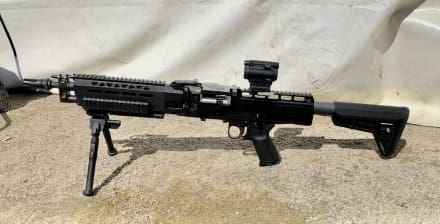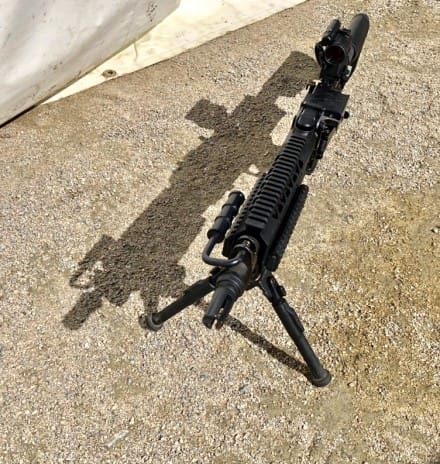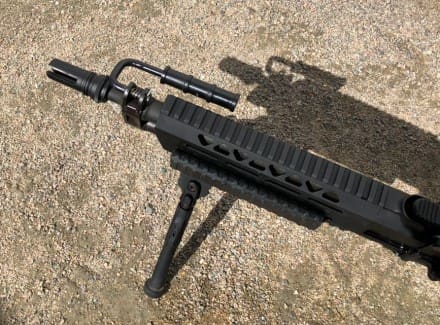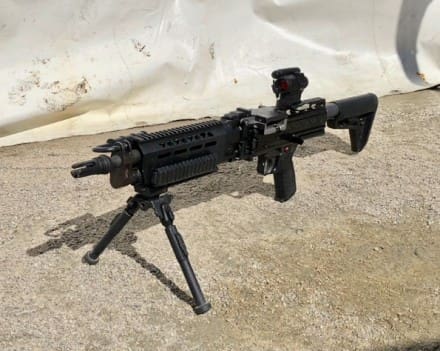I noticed a slight update to the Knight’s Armament Company Lightweight Assault Machine Gun we showed you last year.
The barrel remains 15″ but it’s now a heavy barrel and they added a handle. This, after user feedback, which told them that the original barrel was getting hot and some users didn’t want to have to change it out and others who said it was difficult to change without a handle when they wanted to. Knight’s made both changes.
I’ve got to tell you, it weighs under 9 lbs and carrying it outside to take a photo, it felt like a carbine rather than a belt fed.
Tags: Knights Armament Co






It’s probably just the angle but it looks like the handle would get in the way of the suppressor.
Pretty slick
You had me at “it felt like a carbine rather than a belt fed.” Quite fascinating frankly
Mmmmkay… I get the “light”, and I’ve always admired Knight’s work, but…
Exactly what the hell are we trying to do, here?
The role of the squad support weapon, whether we term it a BAR, an IAR, or a SAW is to do…? What, precisely? There’s a certain amount of incoherence going on with this area, right now, and I don’t find it at all pleasing to observe.
Couple of points–The bipod/shoulder of grunt support system has inherent limitations. You can’t get the most range and repeatable fire control off of a bipod and PFC Schmedlap that the system is ballistically capable of. Just not doable–So, if you’re gonna fire this thing that way, you’re automatically and emphatically not going to get the max range inherently possible out of that cartridge. As well, there’s no point to making Mr. Schmedlap and his buddies haul around what amounts to a bunch of dead weight, in terms of powder, case, and projectile for capabilities we’re not going to make use of, firing from the shoulder and bipod.
So, bipod/shoulder limitation means you’re shooting at maybe, a max of 600-800m with either 5.56mm or 7.62mm. Past that, you’d better be planning on either slinging a metric butt-load of ammo at the targets, or using other weapons. And, to be quite honest, I think that by using 7.62mm in a lot of these near-in roles, we’re overburdening the troops with weight that’s positively counterproductive, in that they’re slowed down by it, and not able to make use of the capability it creates.
So, there’s that: What the hell do you want to do with these weapons, in this role? There are really two main options: Precision auto fire, or bullet hose. Which supports your intended tactics and maneuver speed/agility?
Another point would be the weight/size/firepower triangle, here–If you’re going to keep your gun light enough to be a carbine, and have the gunner keep up with a fast-moving team, then what the hell is the point of making the thing belt-fed, in the first place? A belt-fed gun makes sense in the context of you having a crew and a shitload of ammo for it, which then makes that “fast-moving team” thing kinda hard to achieve. This is why the Marines developed the IAR, and I don’t think they’re necessarily wrong with the idea, either.
As well, if you’re going to pay the penalty for having the gun belt-feed, why the hell not equip it to be capable of the traditional GPMG role, and build a decent truly adaptable all-terrain tripod for it? My issue with this KAC LMG design we’re seeing is that I’m not seeing any sign of development on a equally improved firing platform, in order to wring all the range potential out of the gun.
I think we still have that traditional dichotomy between light and heavy infantry going, and are in denial over the implications. If anything, it’s gotten worse because of all the armor and other gear we’re slinging at these guys. Traditional light infantry come out of the old Napoleonic War idea of the skirmisher–Lightly equipped guys who were out in front of the line infantry formations doing scouting and picking off stragglers, scouts, and officers. Line infantry, the poor sods carrying the muskets and fighting from formations, are the historical antecedents to our current “heavy” infantry, even if we don’t want to admit the fact. The mentality and approach to combat is the same, down both lineages–The light guys rely on fast, agile maneuver, while the heavy guys slog things out with heavy firepower. Back when, we issued the light guys a lighter, more accurate rifle, and armed the heavies with muskets they fired in formation en masse.
Likewise, today that difference shows in the support weapons: Light maneuver-based guys need something like the IAR, and guys that are doing the heavier side of things need something belt-fed and capable of more sustained fire with a higher volume.
I think there’s something to be said for either approach, and that it’s a smart thing if our forces can flexibly switch back and forth between mindsets/modes, but we need to start looking at how all this works with the weapons we buy. As the Marines have found, a belt-fed LMG-class weapon like the SAW doesn’t necessarily meet their perceived needs.
I think we need to start looking at the whole question from a different perspective, and begin considering first what fires effect we want to deliver downrange. What size of beaten zone do we need to create, at what range, and how do we want the projectiles that create that beaten zone delivered, in terms of angles, velocities, and rate of delivery to the beaten zone? How many of these beaten zones do we need to deliver, and in what time frames? What are the other considerations we want to take account of? Is logistics weight a major concern, given how we intend our operational plans to go?
Working backwards from the effect to the weapon system delivering it should enable us to determine whether we want a magazine-fed or a belt-fed solution, what it should weigh, and how it would need to be supported. To me, this is the logical way to be working this issue.
From what I can see, all too much of what we are doing is generated by “Well, what’s technically possible at the gun end…”, and leaving it at that. This is how we wound up with the M240, which while a wonderful MG, is not the weapon you want to hauling around the foothills of the Himalayas.
It is a redo of the Vietnam Seal’s Stoner63. If you want a small team with battalion like firepower, this is exactly what you need
Which is great, if you’re going to train all of your troops to SEAL standards, and then use them as though they were SEALS…
Failing that, equipping everyone as if you were doing the Mekong Delta, 1969 redux might not be the optimal course of action.
Two things.
First mech infantry can’t always go where light infantry goes so light infantry needs the same capability the heavy guys have using your argument.
Second, the Marines and potentially the Brits seem to be making decisions on how to equip the squad with suppressive capability based on the last ten years or so of war. The problem is our next enemy might not be the hit and run type that primarily use IED’s. The BAR, M14 and M16 in the auto role were all found wanting in the squad automatic role and when the squad needed a real auto weapon MMG’s were pressed into action with all the weight they entail. The SAW is a step forward though it should have been redesigned a bit more around 5.56 than just downsizing from its original 7.62 daddy (with an appropriate weight savings). Seems certain organizations are going i have to be relearn history they already experienced.
Precision fire as a suppressive tool works well when you know where the target is. Too often in combat you don’t and if one can’t suppress fire and maneuver fail. “Bullet hose” whose more technical term is sustained automatic fire is the tool to suppress an area like when you don’t know exactly where the bad guy is. They also come in handy when you are outnumbered, a situation we havbn’t had to face too much in the last decade or so. It will not always be that way.
Oh, and the need for “sustained automatic fire” drives the train for belt fed systems unless you want to tag someone to reload magazines in the middle of a firefight vs attaching another belt.
Will, like I’ve been saying… Figure out how you intend to fight, then design and procure to match.
I don’t have a brief for either path–I think you could make super-light infantry work, kinda the way some ultra-light hikers do it. The enemy, going back to the VC and NVA…? They sure as hell have, and the agility they gained from doing things the way they did enabled them to do a lot of damage to our guys in situations where they were able to dictate the terms of the engagements. Once they got it “stuck in”, and we had them where our strengths lied (in Vietnam…), we were able to chew their formations up pretty well, and all that agility didn’t do them a lick of good.
But, the problem was in getting them into those situations. All too often, our guys were too heavily burdened and logistically bound to things that they didn’t need to survive, and we simply couldn’t move quickly enough, tactically and operationally.
The equipment you need for fighting the “ultra-light” infantry, where the guys are living off the land and barely carrying enough ammo for a single firefight…? That’s a much different set of gear than the guys we’re intending to put into a line “heavy” infantry outfit, and stand and fight the way we’re doing it currently. I would submit that contemplating this state of affairs would be wise, and then determine what the hell we’re going to be buying based off of that.
“Ultra-light” probably means accepting a bunch more casualties, and not just from leaving body armor behind, either–You’re gonna have guys pick up water-borne diseases from living off the land, and they’re going to wear out a hell of a lot quicker, physically. If that’s what we’re gonna do, then we ought to be buying M27s for the squad support weapon, and get this KAC LMG in 7.62 for their slightly heavier support needs at the platoon level. Or, the PKM. If not, then the decision tree going down the other paths will result in a much different weapons package.
The weapons need to support how we fight. You don’t hand the light guys a water-cooled WWI heavy support MG to carry in the squad, and you don’t hand your guys doing the heavy infantry role something like a slightly more robust individual weapon, either.
If I were making the decisions, my instinct would be to grab this KAC offering with both hands, and say “More, please…”. But, I’d be doing that knowing that I was intending to fight in a manner where these were appropriate. I’m not sure that the folks running the cluster-fark that is the Big Army these days have really thought this whole thing through that carefully, to be honest.
As I said above–Start out from what effect you need downrange, in terms of beaten zone density, size, and how many of those you need to deliver for the way you plan on fighting. Then, work backwards to the weapon, designing accordingly. This is what I don’t see them doing, and it worries the hell out of me to observe.
Your response is an offshoot from my point being whether the Infantry squad needs a machinegun or a precision rifle. The answer is both but the machinegun is more important of the two.
Anyway, I’ll try to respond to some of your points.
The VC and the NVA made it work? The same guys that lost EVERY major and most minor engagements against US forces for a decade?
Accepting a bunch more casualties? “Bunch” is an understatement when you are comparing 850k dead to 60K. BTW, a third of which were non-combat deaths.
I believe the stats above make the ultralight infantry approach a non-starter for the US. America would simply not accept it and THAT’s why we lost Vietnam.
FYI, it’s exceedingly difficult to kil an insurgency just by killing if they are willing to accept casualties. The way to defeat an insurgency is rob it of its ability to wage war. Defeat it in the field but also take out its ability to sustain itself. Eliminating sanctuaries is key. This is why Nam lasted so long as well as Afghanistan.
Anyway, when discussing machineguns we are talking tactics not operational or strategic concerns and tactics never trump strategy. (You’ll always loose your war if your strategy is wrong.) Some take that loss the wrong way questioning tactics when they should be questioning strategy.
Tactics. Yes, you always want to determine what effects you have on the ground. Have we lost any engagements on the ground? I don’t think so but in Afghanistan we have allowed the enemy to withdraw behind an artificial line (land border) and sustain itself. The type of machinegun doesn’t fix that. BTW, the NVA had at least one RPD per squad and always kept it manned despite casualties.
Why? Because they realized then (and it hasn’t changed) suppression is achieved by a higher volume of fire than the enemy. Machineguns always do that better than precision fire. (Not minimizing the importance of precision fire here but machineguns work both when you know exactly where the target is, required for precision fire and when you don’t.)
Another thing one has to consider when creating an Army is what is the threat and where will we fight. We have a very wide spectrum of threats. The current force can respond to them. Our lack of success strategically isn’t a reason to change our organization at the tactical level. Though you always want to keep your thumb on the pulse and stay current. If I saw the Russians, Chinese, Iranians, Norks, etc ditching body armor and squad machineguns your superlight living off the land approach might bear some inspection.
So in closing, it seems in your response above you’ve changed your initial position now embracing the KAC vs the M27 type solution which was all my answer was about.
I think I’ve been clear that I don’t embrace any of the solutions, so long as they’re not integrated into the tactics and operational intent. Align those, and I can see either solution working.
I think you’re making a big mistake in saying this is strictly a “tactics” thing, when it isn’t. Operational intent and even grand strategy play into these choices about which specific compromises you’re going to make. Key historical example with regards to the MG? Probably the German choice to build the MG34/42 family of guns, and then wrap their tactics and operations around those. But, that’s not what they did, is it? They chose their tactics and operational intent, and then built the guns to match both of those.
Key pertinent features of the German MG family and the tactics/operational intent they built were that the German infantry were going to be mostly foot-mobile, and operate without the lavish support US and UK infantry received. This meant that they had to wring the utmost out of their organic weapons, both direct and indirect fire. Thus, the emphasis on the flexibility of the MG, its range, and things like all the little supporting accessories that made their gun teams and tactical systems so lethal. Same-same with the mortars, and that leads into why they made those choices. First and foremost, from their standpoint, was that they had had the Versailles treaty force them into a “training holiday” for their reserves, which had proven to be so effective in WWI. Without the vast reserves of trained manpower, they needed to do two things: Economize on the need for that trained manpower, and to spread what they did have around, making it as effective as possible. Thus, the MG doctrine–They didn’t have the trained infantry to serve as riflemen in the reserves, so they went with the “distilled infantry” solution of the most effective MG they could build, trained the crews to perfection, and then relied on them for much of the early part of the war.
Which is why the exchange ratios were so bad between Germans and unsupported Allied infantry.
Weapons must align with tactics and operational intent. If you’re going to rely on masses of poorly trained infantry that you draft off the streets, put in uniform, and then expend with ruthless unconcern, the weapons set you buy for them is not going to include sophisticated gear that only a long-service trained professional is going to be able to get the most out of. For one thing, you won’t be able to afford enough of those for a true mass army, in most cases. For another, it’s a huge waste of resources to do that, and you’d be a lot better off buying STENs and a bunch of ammo. Likewise, if you’re going to have a small professional force, then equipping them with cheap, poorly-made and less-than-accurate weapons is another case of wasted resources, only in manpower instead of equipment.
You could make either an M27 or a KAC LMG approach work; the problem is that we’re not bothering to think the “rest of the picture” stuff out, and do the homework to make either approach work. Procurement seems to be more driven by the “Ooooh, shiny!!” and faddishness aspect than actual forethought and careful consideration.
I respect the Marine choices to go to the IAR, but that’s not the path I’d take–I want that belt feed, and the ability to dispense mass amounts of fire, when needed. But, if the logistics can’t keep me supplied with the necessary ammo, and the tactical and operational optempo makes lugging that belt feed around difficult to impossible…? Well, hand me that IAR.